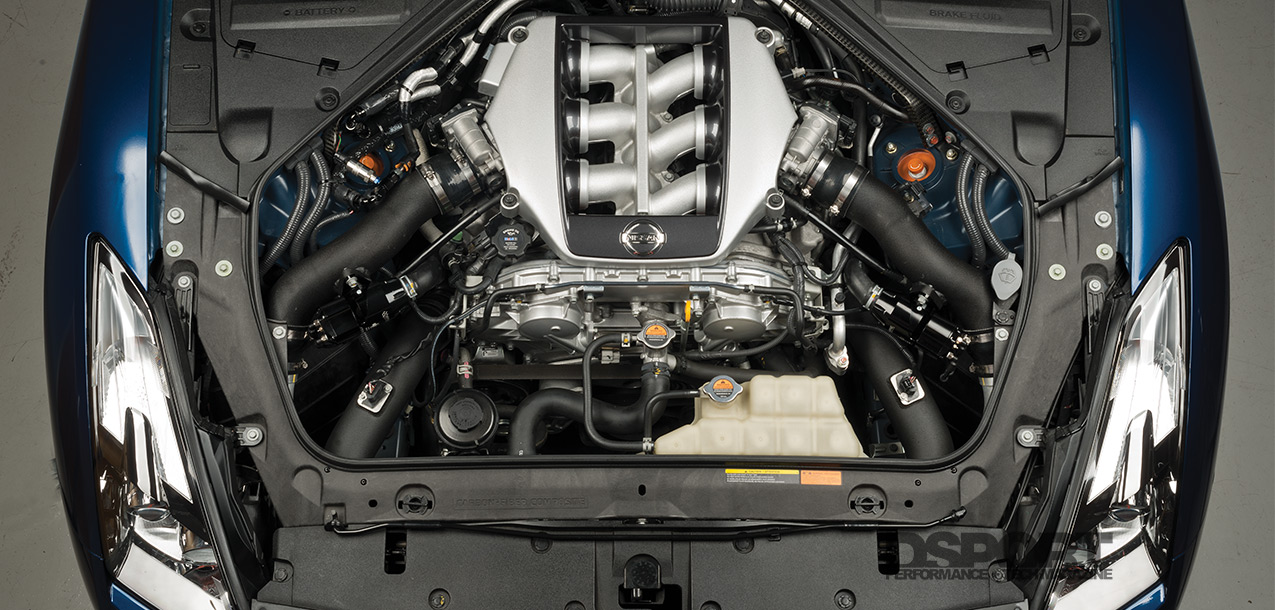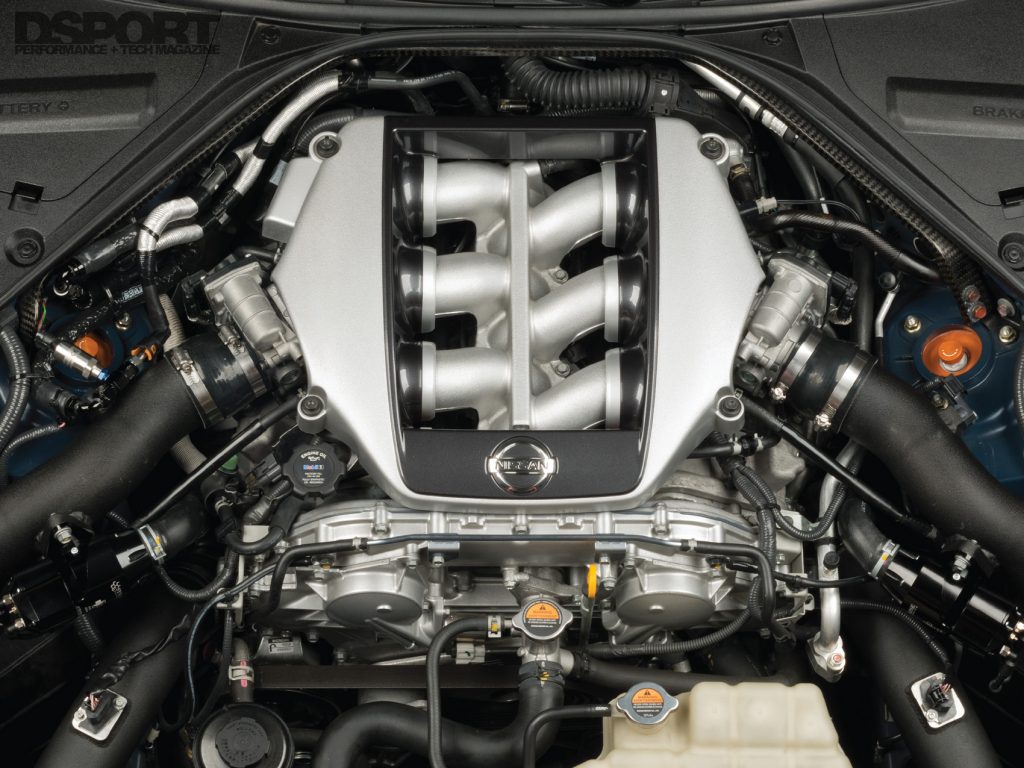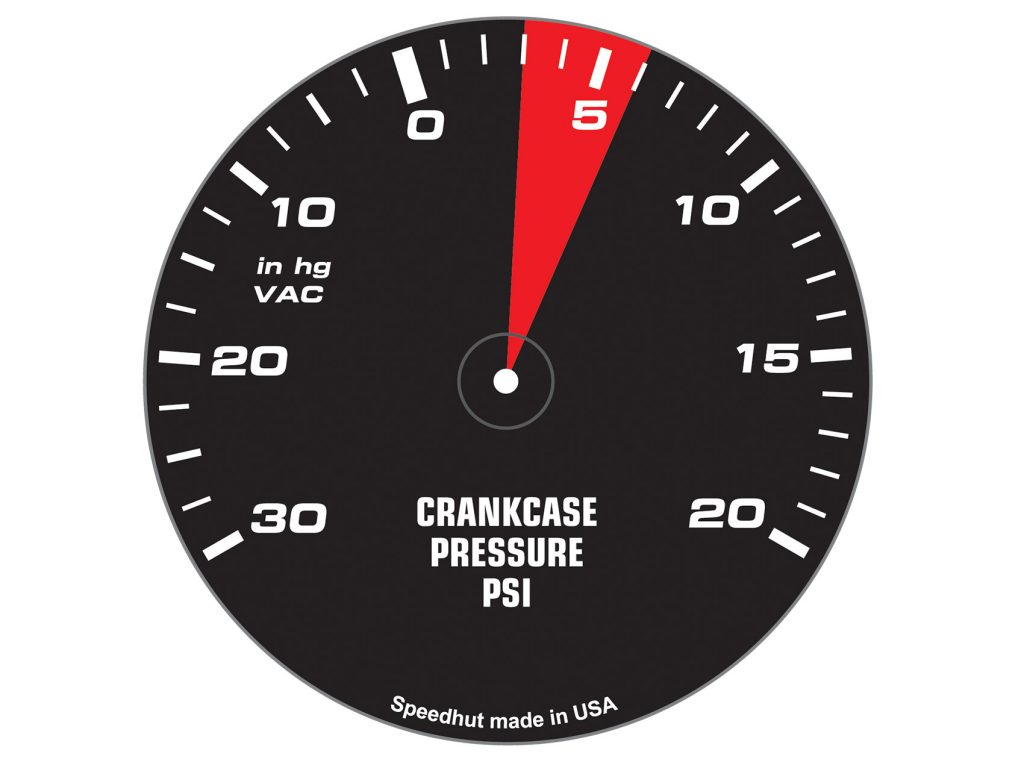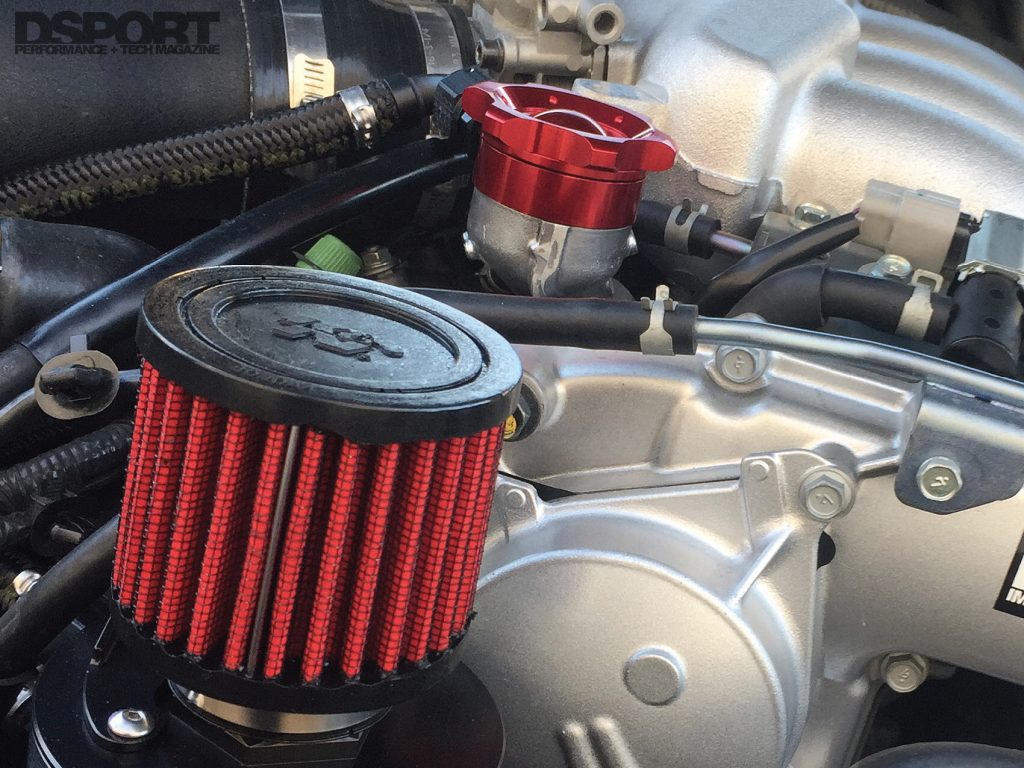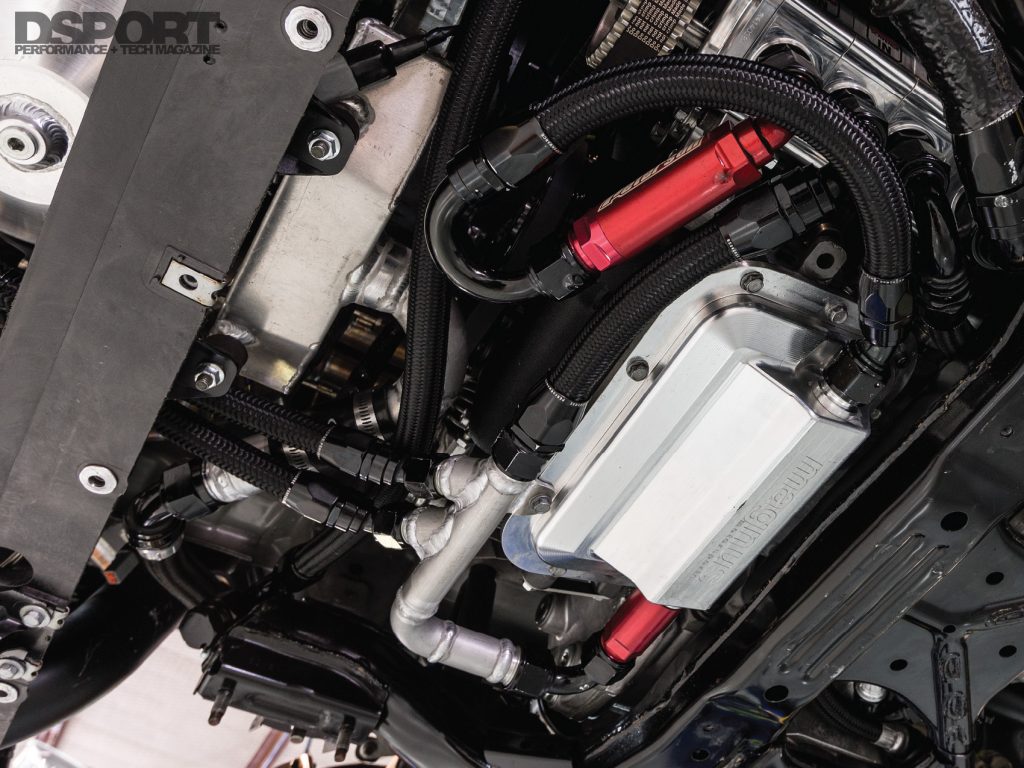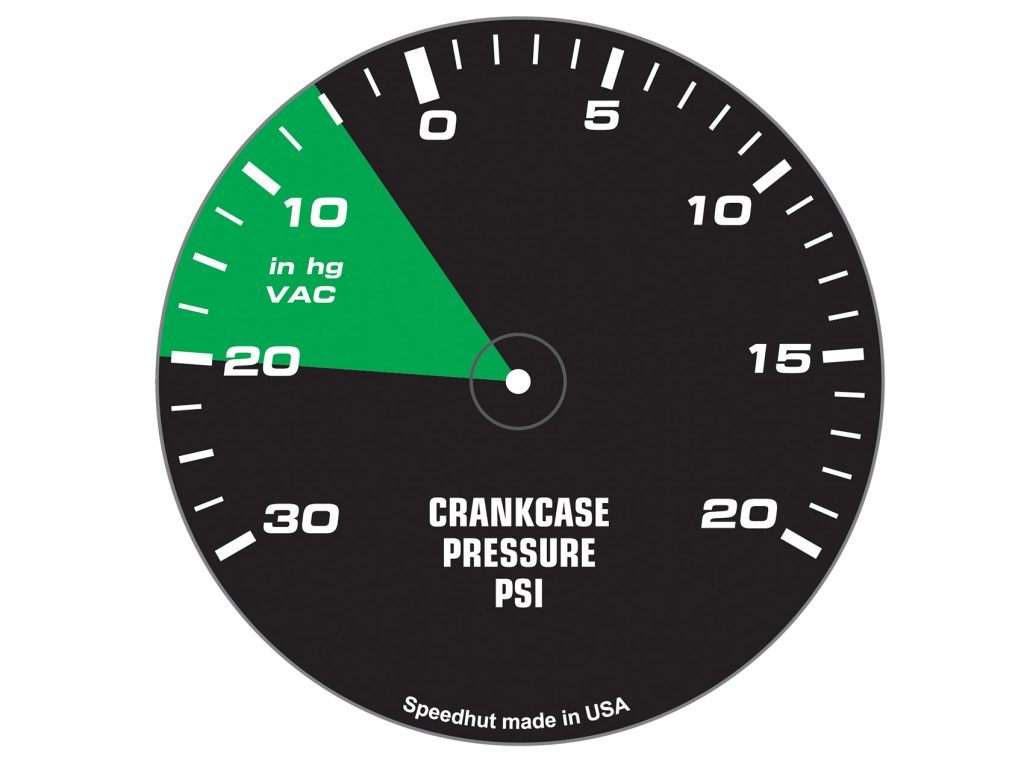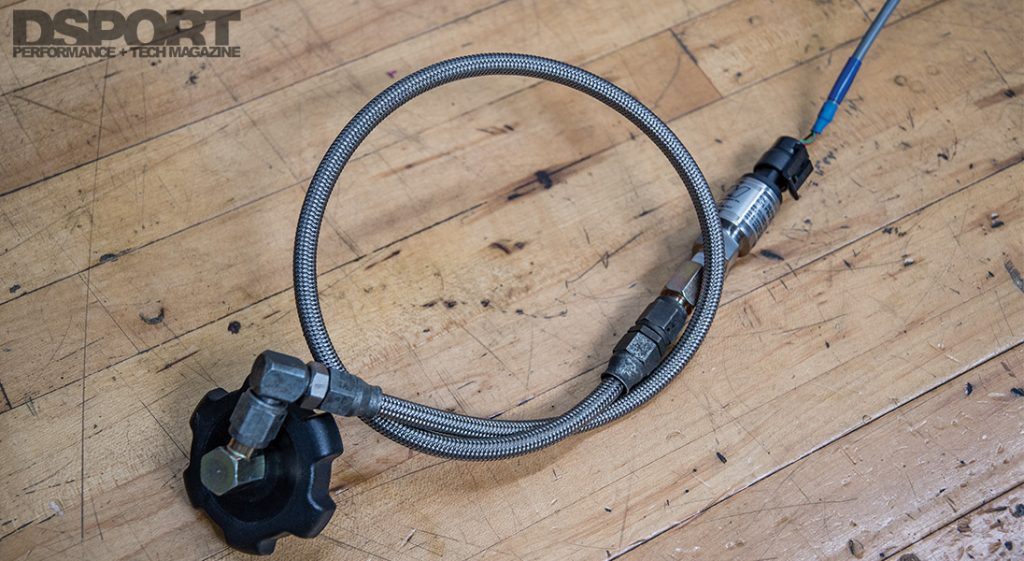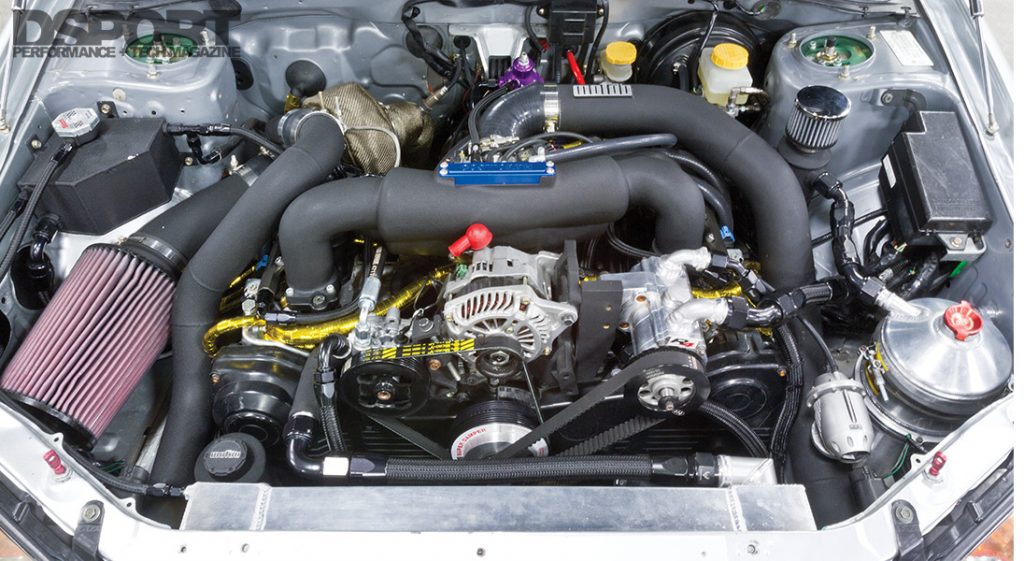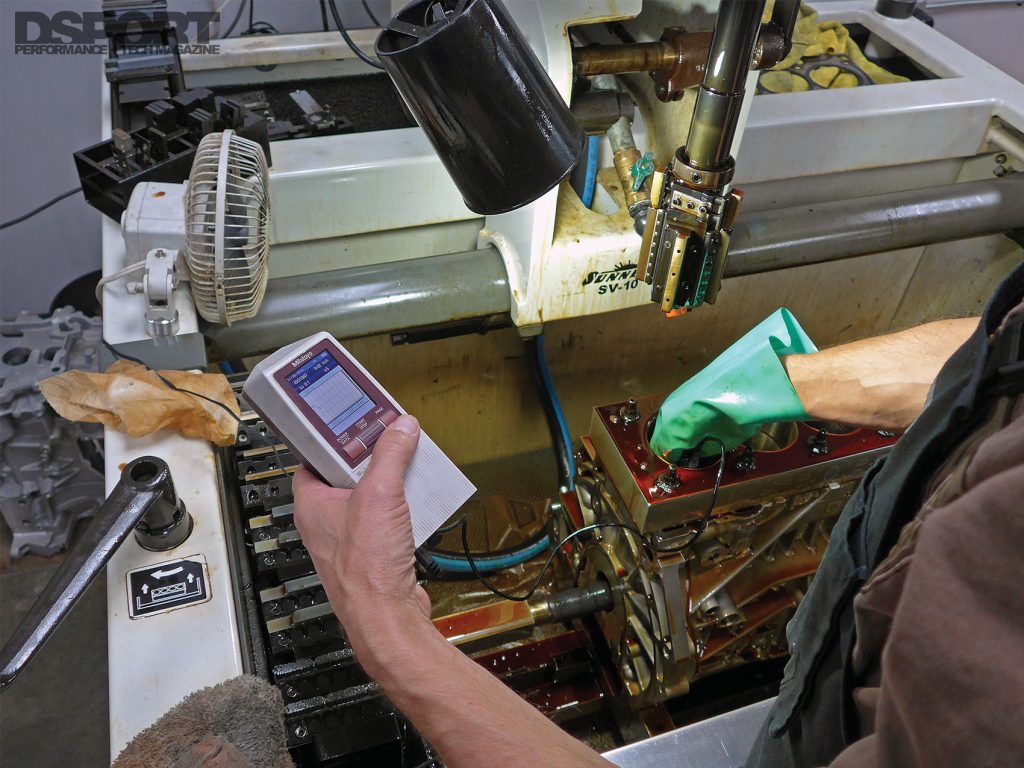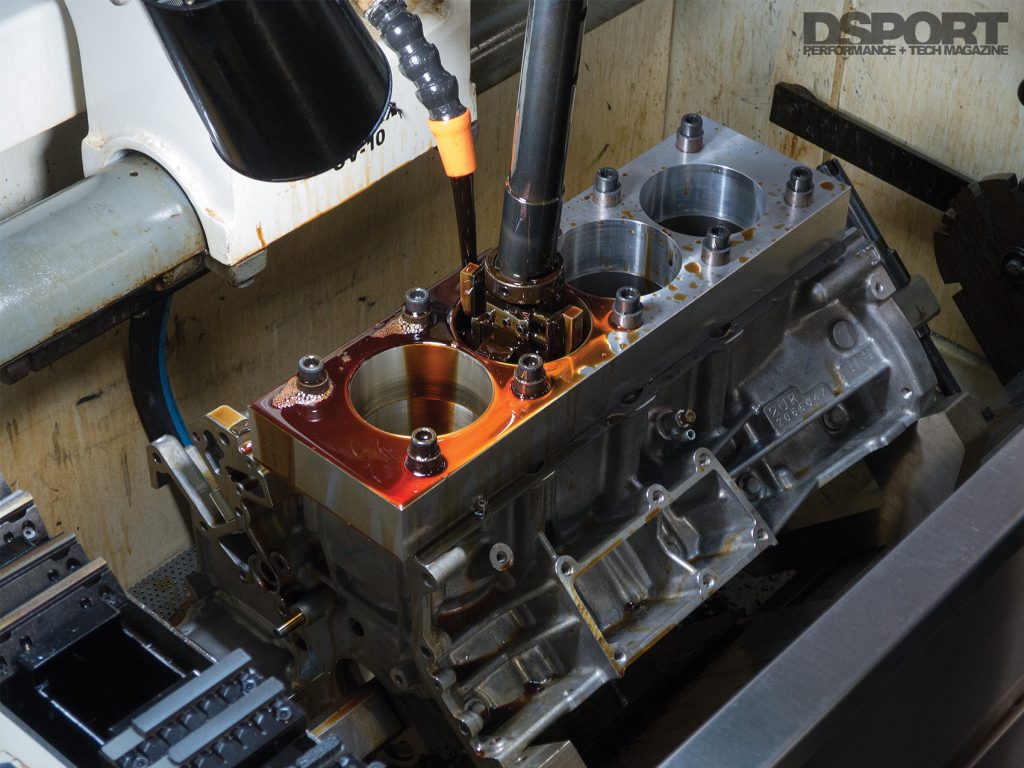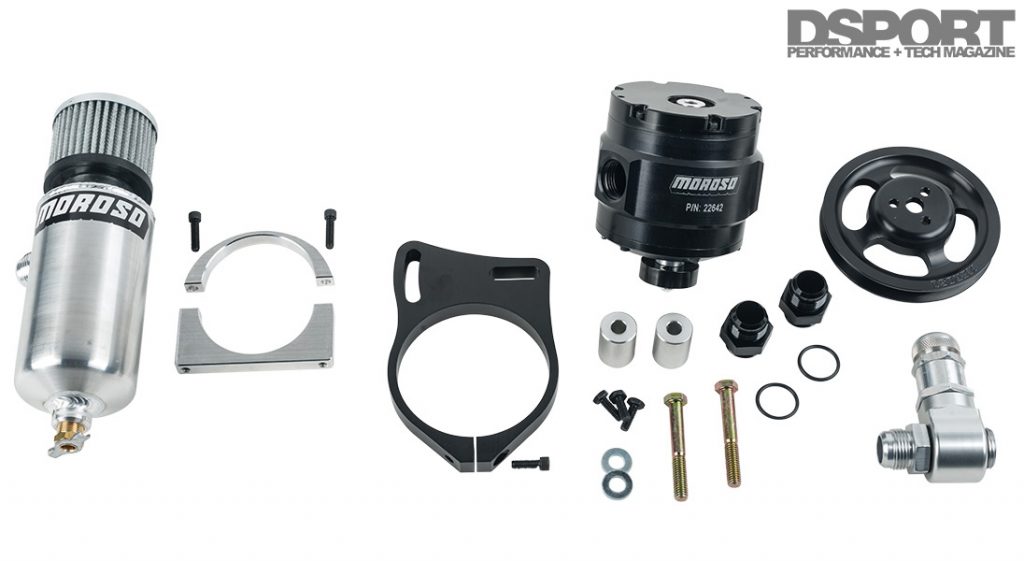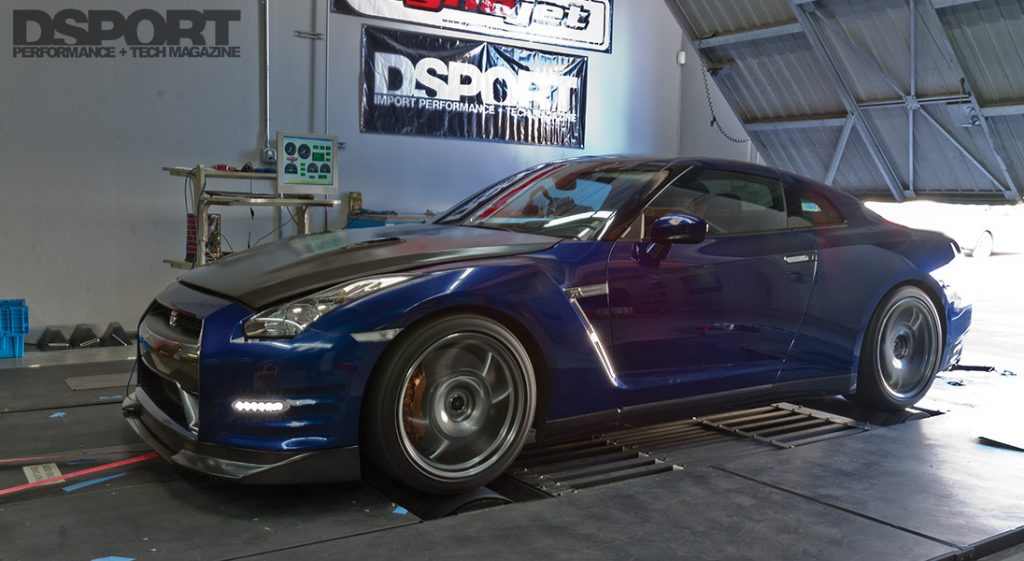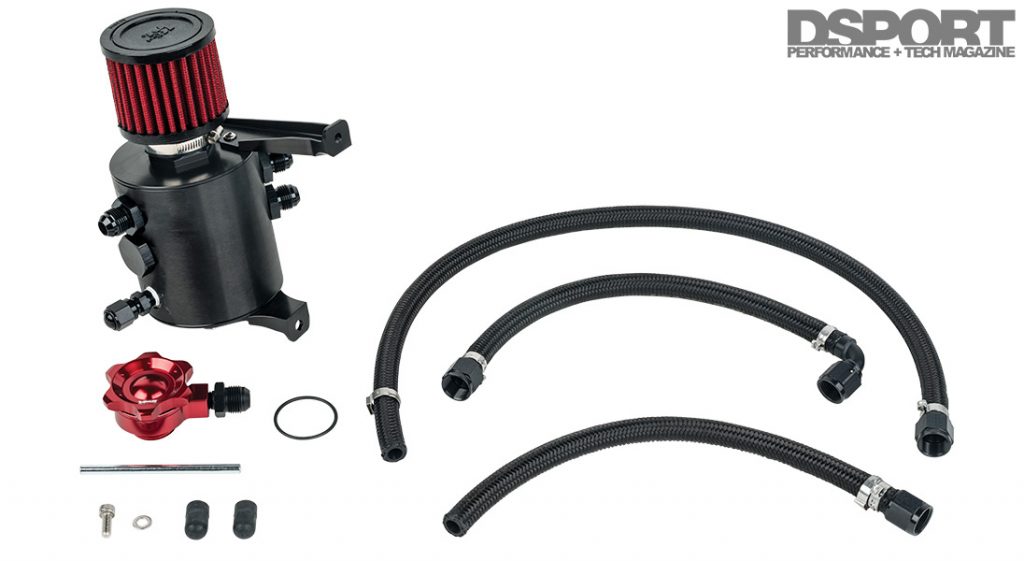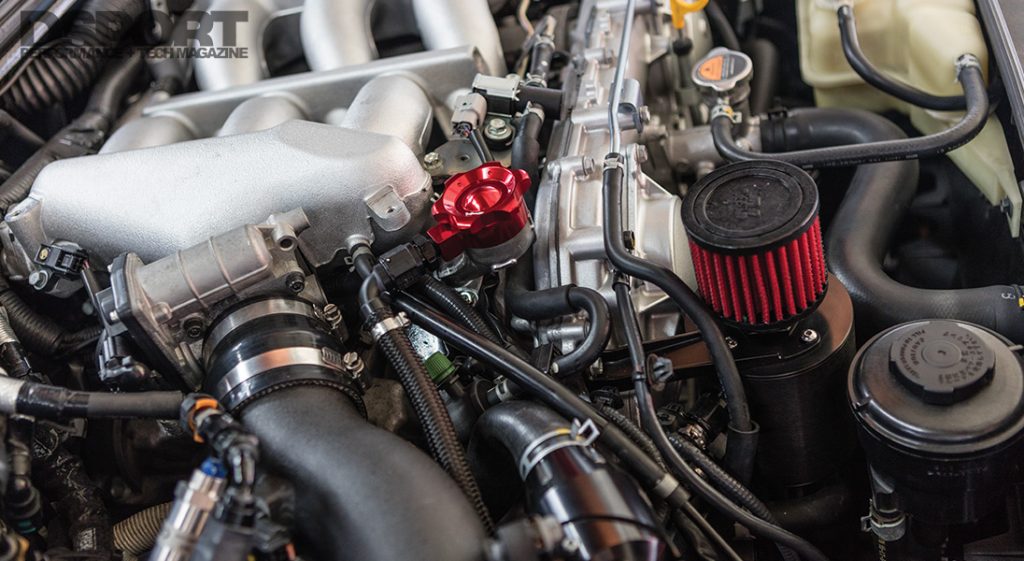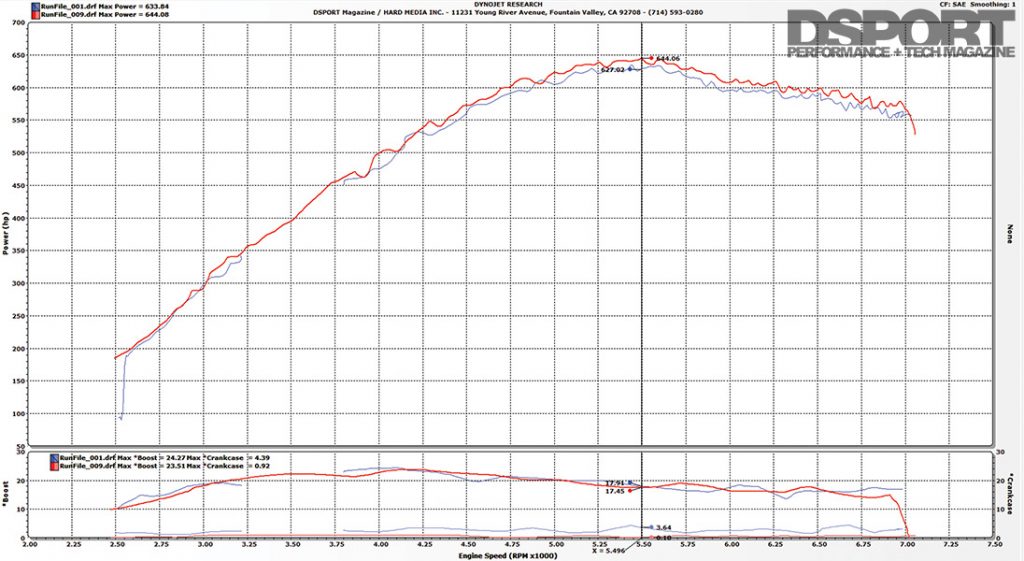It’s no secret that higher boost pressure translates into higher torque and power outputs. Crank up the boost pressure, get more power. While many understand the merits of increasing the pressure of the air going into the cylinders, fewer understand the virtues of decreasing the pressure within the crankcase. While many high-end classes of racing from Formula One to Pro Stock rely upon dry sump oiling systems that run the crankcase at negative pressure (vacuum), few entry-level racecars and even fewer street cars benefit from the negative crankcase pressures of a dry sump oiling system. The cost and complexity of a dry sump oiling system puts it out of reach of many. Fortunately, the benefits of reduced crankcase pressure can also be accomplished by simpler and more cost-effective means.
Text by Michael Ferrara // Photos by Joe Singleton // Illustrations by Paul Laguette
DSPORT Issue #176
The Solutions
Optimized crankcase ventilation systems and the addition of a vacuum pump can swing positive crankcase pressures to zero (atmospheric) or even negative values (vacuum). These solutions may be achievable for under $100 to upwards of $1,500. Even on the high-end, this may only represent less than 25 percent of the cost of a dry-sump oiling solution. For those that can afford the expense, there is no substitute for a well-designed, high-quality dry-sump system and all of the benefits that can be delivered. For the rest of us, the benefits of the lower-cost alternatives are well worth the cost. Once a solution is employed to reduce crankcase pressure, the result is “free horsepower.” This is “free” in the sense that no additional fuel needs to be burned to realize the power. Instead, the reduced crankcase pressure is simply freeing up or realizing new horsepower from increased engine efficiency and reduced power losses.
The factory crankcase ventilation system is a positive crankcase ventilated design. At idle and under high vacuum, the PCV valve uses engine vacuum to reduce the crankcase pressure to zero. However, when intake manifold vacuum is zero (or under boost), there is no intake manifold vacuum to reduce crankcase pressure, so the pressure gets directed to the compressor inlets. In most cases, this will create positive crankcase pressure on the order of 3 to 6 psi, robbing performance.
POSITIVE
An aftermarket solution, like the Buschur Racing Pro Plus R35GT-R Catch Can eliminates positive crankcase pressure by venting the crankcase pressure to the atmosphere by way of the vented catch can. Lower crankcase pressures (0-to-1 psi) result in better ring seal and increased performance usually on the order of a 2-to-3 percent increase in power. The system also eliminated the issue of introducing oil from the crankcase into the compressor inlets, charge piping and intercooler.
ZERO
A dry-sump oil system or a pulley-driven vacuum pump can evacuate crankcase pressure so effectively that it can create a vacuum. The vacuum is typically regulated to run at -5 to -20inHg on most applications. The negative crankcase pressures (a.k.a. vacuum) further improve ring seal. Performance usually increases on the order of 3 to 6 percent.
VACUUM
The Game Plan
Understanding how crankcase pressure is formed is key to understanding how it can be reduced. In the first part of the “Less Pressure, More Performance” series, we will define crankcase pressure and its causes before identifying the methods to reduce or eliminate crankcase pressure. To demonstrate the real-world results, we’ll dyno test a simple solution on our Project R35 and witness the magnitude of the results.
Getting Cranky
What is crankcase pressure? Quite simply, it’s the pressure above atmospheric (or positive pressure) in your engine’s crankcase. If you were to place a pressure sensor or pressure gauge on the crankcase of your engine, you could measure the amount of crankcase pressure developed in your engine. On the suggestion of David Buschur, we added a pressure sensor to our dyno to measure crankcase pressure on any car that we dyno test. On engines using the factory designed crankcase ventilation system (a PCV or “positive crankcase ventilation” system), we typically measure peak crankcase pressures on the order of 2.5 to 6.0 psi when the engine is in normal running order.
The actual crankcase pressure can be recorded by placing a fitting in the factory oil filler cap and measuring the pressure with a standard pressure sensor. We now log every engine from every car dyno’d at DSPORT.
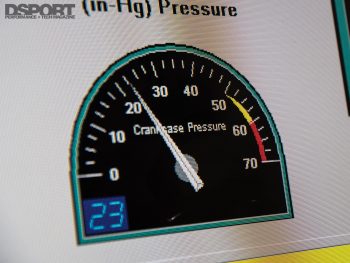 So what causes crankcase pressure? In most cases, crankcase pressure is not primarily from the movement of the pistons up and down in the cylinder. This is because for every piston moving down a cylinder (potentially reducing the size of the crankcase and increasing the pressure), there is another piston moving up in a cylinder (increasing the volume of the crankcase and reducing the pressure). Hence, the volume of the crankcase remains fairly constant at any time. While there is an actual difference in crankcase volume on some engine designs through the crankshaft’s rotation due to rod angles and other factors (inline four cylinders have a different crankcase volume with the crankshaft horizontal or vertical in its rotation), the bulk of the increase in crankcase pressure is actually coming from elsewhere. In fact, the primary source of crankcase pressure is from the leakage of the combustion pressure in the cylinders past the rings. This phenomenon is often referred to as “blow by”; referencing the fact that some of the combustion pressure gets past the ring seal in the cylinder. Of course, maximizing the quality of the ring seal in the first place should always be the goal (see Improving Ring Seal sidebar), but understanding its effects that the leaked combustion pressure is necessary to understand the advantage of reduced crankcase pressure.
So what causes crankcase pressure? In most cases, crankcase pressure is not primarily from the movement of the pistons up and down in the cylinder. This is because for every piston moving down a cylinder (potentially reducing the size of the crankcase and increasing the pressure), there is another piston moving up in a cylinder (increasing the volume of the crankcase and reducing the pressure). Hence, the volume of the crankcase remains fairly constant at any time. While there is an actual difference in crankcase volume on some engine designs through the crankshaft’s rotation due to rod angles and other factors (inline four cylinders have a different crankcase volume with the crankshaft horizontal or vertical in its rotation), the bulk of the increase in crankcase pressure is actually coming from elsewhere. In fact, the primary source of crankcase pressure is from the leakage of the combustion pressure in the cylinders past the rings. This phenomenon is often referred to as “blow by”; referencing the fact that some of the combustion pressure gets past the ring seal in the cylinder. Of course, maximizing the quality of the ring seal in the first place should always be the goal (see Improving Ring Seal sidebar), but understanding its effects that the leaked combustion pressure is necessary to understand the advantage of reduced crankcase pressure.
Less than Zero
When pressure in the crankcase can be reduced, taken to zero or even made less than zero (vacuum), good things happen. Reduced crankcase pressure improves the sealing of the rings in the cylinder. Increased differential pressure on the piston rings results in improved ring seal. On turbocharged applications, exhaust backpressure is generally higher than crankcase pressure, so the exhaust stroke has little issues with ring seal due to the differential pressure. Even on an all-motor application, the differential pressure on the rings will be high during the compression and power strokes. Unfortunately, the differential pressure during the intake stroke may be so low that the ring fails to make an ideal seal in its groove when crankcase pressures are high. Having zero pressure or better yet vacuum (less than atmospheric zero), improves the ring seal during the intake stroke. In fact, some of the issues with losing ring seal at higher engine speeds or when thicker rings are used can be offset when the crankcase is under vacuum instead of pressure. If fact, the best engine developers always consider the type of oiling system and amount of crankcase pressure (positive, zero or vacuum) that will be expected when selecting the ring package for a specific application.
PCV Positive
Nearly all modern internal combustion engines use a wet-sump oiling system and a crankcase ventilation system that allows a positive amount of crankcase pressure to be present under nearly all running conditions. During circumstances where high intake manifold vacuum is present (idle, light-throttle cruising and deceleration), a PCV valve (essentially a one-way check valve) in the system allows crankcase pressure to be relieved into the intake manifold (the vacuum in the intake manifold helps to draw the pressure from the crankcase). Under running conditions where the intake manifold vacuum is lower in absolute pressure to the crankcase pressure, crankcase pressure is barely measurable. This applies to an engine in good mechanical order. Engines with excessive cylinder wear or poor ring seal may create high crankcase pressures even when the intake manifold vacuum levels are high.
Under situations where the vacuum in the intake manifold drops to zero or turns to a positive pressure (under “boost”), the one-way PCV valve closes and the engine becomes dependent on another means to relieve crankcase pressure. This other means on most turbocharged vehicles involves having the positive crankcase pressure push into the compressor inlet tubes. These compressor inlet tubes may be at atmospheric pressure or at a slight vacuum. While this system can help reduce the positive crankcase pressure, it does have drawbacks. The flow of crankcase vapors into the compressor inlet tubes contains oil mist and vapor that often condenses in the turbo inlet, turbo compressor section or in the intercooler or intercooler plumbing. Having this film of oil building up in the intercooler decreases its efficiency.
Venting to Atmosphere
Before the early 1960s, the crankcase evacuation system on vehicles simply vented to the atmosphere through a few “breathers.” In some cases, road draft tubes were employed along with the breathers to create some negative pressure (vacuum) in the system when the vehicle was at speed. As people became concerned with pollution, these systems disappeared and the positive crankcase system became the standard.
While an atmospherically vented system may seem crude and can only be legally used on racing/off-road vehicles, this type of simple system will lower the crankcase pressure on most engines to a near atmospheric (no gauge pressure) level when its properly designed. The Buschur Racing Pro Plus GT-R Oil Catch Can system is an example of a well-designed, vented to atmosphere solution for R35 GT-Rs. This system ties both valve covers and the engine oil filler neck into a centralized catch can location that vents all of the crankcase pressure to atmosphere.
Improving Ring Seal
Better ring seal leads to improved performance and efficiency from any piston engine. Manufacturers, machinists and engine developers know that rounder cylinders, flatter piston ring grooves, thinner piston rings and improved cylinder finishes can all contribute to improved ring seal in the cylinder. Ring seal quality can have a bit of a chicken-and-egg relationship. Whenever the ring seal is improved, less blow-by is put into the engine’s crankcase. Hence, crankcase pressures are also reduced. Lower crankcase pressures improve the quality of the ring seal. At the end of the day, the best ring seal possible is the goal. When developing and building engines at our Club DSPORT division a number of processes are employed to deliver the highest-quality ring seal possible. These processes and procedures include:
• Cylinder honing with an optimized honing plate (a.k.a. torque plate): this process corrects for the bore distortion present when the cylinder head is bolted to the block. The end result is a rounder cylinder.
• Cylinder finish optimization using a profilometer: preparation of the surface of the cylinder to ideal conditions cannot be done without the use of a profilometer. The honing process takes 3 to 4 times the normal time, so expect to pay between $100 and $150 per cylinder for a precision machine shop that has the tools and knowledge to do this correctly. This process results in a cylinder surface that is optimized for the piston ring material and finish.
• Piston Selection: while many pistons look the same, the critical dimensions that are not visible to the naked eye will determine the piston’s ability to keep the rings flat and working properly in the engine. Flatter and more parallel ring grooves simply deliver better ring seal. The clearances and tolerances in the ring grooves also plan an important factor. For optimal ring seal, the ring grooves should be machined with a specific ring set in mind.
Ring Selection: all other factors being equal, a thinner ring will deliver better ring seal than a thicker ring. This is primarily due to two reasons. First, thinner rings are lighter and have less inertia. At high engine speeds, lighter rings will avoid becoming unseated in the ring grooves as the piston changes directions. Second, the thinner rings conform to the irregularities in the bore better. So why doesn’t every engine just run the thinnest rings available? The tradeoff in going thinner is the ability to transfer the heat from the piston to the cylinder wall. A thinner ring should be selected from superior materials with superior coatings due to the elevated thermal loads that it will endure. When thinner piston rings are used, other means of cooling the pistons (i.e. piston oil squirters) are essential to extending the life of the pistons and rings.
If you are looking to get the benefits of running negative crankcase pressure, but you can’t afford a dry-sump oiling solution, explore a vacuum pump solution. A properly designed vacuum pump system can deliver like crankcase vacuum to a dry sump.
Vacuum it Up
To get the pressure even lower (into a state of vacuum), another option is to employ a vacuum pump on your engine. Moroso is one of the most popular sources for these solutions. Moroso offers a lineup that includes both 3- and 4-vane vacuum pumps, various brackets and a number of pulley options. Since many of the off-the-shelf brackets are made for popular domestic engines, chances are that you’ll have to fab a bracket to make it fit. In part 2 of this series, we’ll explore the selection and setup of a vacuum pump on a conventional wet-sump engine.
The Baseline
Before installation of the Buschur Racing Pro Plus GT-R Oil Catch Can, we dyno tested our Project R35 to establish the power baseline. Our Project R35 features the factory engine and factory turbochargers with a full complement of bolt-on performance parts under the control of a MoTeC M1 plug-in ECU. Running on pump E85, we have the engine tuned to make all of the power possible with the factory turbochargers. The factory turbochargers are maxed out and cannot hold boost pressure to redline.
In addition to recording horsepower, we also recorded boost pressure and crankcase pressure. With the factory crankcase ventilation system in place, peak crankcase pressures reached 4.4psi. Peak boost pressure checked in at 24.3psi, while the boost pressure at peak power was 17.9psi. Peak wheel horsepower registered 633.84 horsepower.
In looking at the data, we noticed that peak crankcase pressures occurred at engine speeds that correlate with peak torque output. Since peak torque output occurs when cylinder pressures are also at a maximum, this confirms the belief that crankcase pressure is most influenced by the leakage of cylinder pressure through the rings (blow-by).
The Buschur Racing Pro Plus R35 GT-R Catch Can system provides all the necessary parts to convert the OEM crankcase system to a vented system for increased performance.
The Installation
Always looking to learn new skills, our graphic design intern Mikiko Akaogi jumped at the opportunity to install the Buschur Racing Pro Plus GT-R Oil Catch Can. You can find the video of her installation on DSPORTMAG.com or the DSPORT YouTube channel. The process was fairly simple and straightforward. Essentially, the new system ends the connection between the compressor inlets and the crankcase (now no oil can get into the charge air system from the crankcase). The crankcase tubes that previously fed the compressor inlets are redirected to the catch can. An additional port goes to a special oil filler cap that provides one additional path for crankcase pressure to vent into the catch can. The system has an exceptional fit and installation requires only simple hand tools and about an hour or so of time.
The Test
After installation, it was time to see if any differences could be realized. Again, we logged horsepower, boost pressure and crankcase pressure. With the new crankcase system in place that vents to the atmosphere (again this is only for off-road, racing use due to increased emissions), peak crankcase pressures dropped to under 1.0 psi (0.92psi). Unexpectedly, peak boost pressure also dropped a bit. Peak boost pressure was down 0.7psi, registering a peak of 23.5psi, while the boost pressure at peak power was down about 0.5psi, dropping it to 17.45psi. Despite a lower boost pressure, peak horsepower still increased to 644.08. This represented a gain of nearly 10 horsepower. Had we been able to equalize the boost back to the 17.9psi peak, horsepower would have been just over 653 horsepower. This would have represented a gain of nearly 20 horsepower or about 3.0-percent of the total output of the engine. On applications with non-stock turbos, a solid 3.0-percent gain or about 20 horsepower on a 650-horsepower VR38 will be realized. On a 1,000 horsepower VR38, expect to see the gains closer to the 30 horsepower mark.
Our testing of the Buschur Racing Pro Plus Catch Can kit installed on our Project R35 indicates that a 3.0 percent gain in power can be expected at like boost levels. That’s about 20 horsepower on a 600 horsepower VR38 or 30 on a 1,000 horsepower build. Since ring seal is improved and the engine’s airflow demands will improve, do not be surprised to see the boost pressure drop 0.5~1.0 psi at the same wastegate duty cycle. We realized about a 10 horsepower gain at a boost pressure that was 0.5psi lower. Compensating for the loss of boost pressure, our gain would have been 20 horsepower which is exactly in line with Buschur Racing’s in-house results.
Dyno Results Confirmed
The independent results that we obtained are nearly identical to the results obtained by Buschur Racing. On an R35 GT-R making 580whp, a total of 22 additional horsepower at the wheels was obtained when boost pressures were identical. Crankcase pressure readings were also along the same lines as it dropped from the 4.5psi range to below 1 psi.
The Bottom Line
The Buschur Racing Pro Plus GT-R Oil Catch Can delivered some nice performance gains while delivering important secondary benefits (no more oil into the compressor inlet, intercooler pipes or intercooler). With a well-designed vented system, similar benefits should result whenever positive crankcase pressure can be reduced. So how much better would an engine perform if the crankcase was actually in a state of vacuum (pressure lower than atmospheric)? This is what we look to explore in our next installment of “Less Pressure, More Power.”
Full Photo Gallery on Page 2 >>


